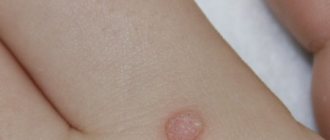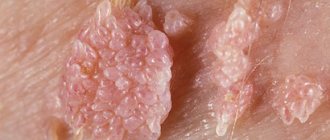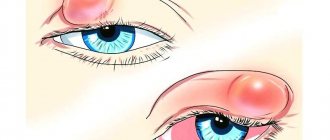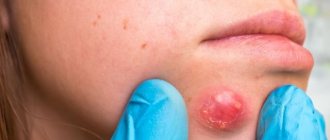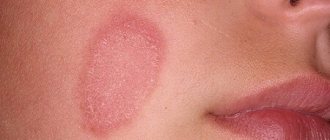- Viral skin diseases: causes, classification
- Herpes
- Shingles (herpes zoster)
| |
Vulgar or simple (ordinary) warts are caused by the human papillomavirus-2 (HSV-2), which selectively affects the epidermis. Vulgar warts on the hands make up 70% of all warts and are localized benign hyperplasia of the epidermis.
Infection with warts occurs through contact—by contact with the affected skin. The penetration of the virus is facilitated by minor injuries, leading to disruption of the integrity of the stratum corneum of the epidermis, dry skin, acrocyanosis, hyperhidrosis, and a decrease in the pH of the water-lipid mantle.
Routes of infection with human papillomavirus, which causes the development of warts
The virus can reach a healthy person through direct contact - a handshake, for example, or through infected objects: toys, handrails on public transport. Two to three hours of virus life in the external environment is enough for someone to become infected with warts: the infection is quite common.
Cosmetic defect is the main complaint of patients with warts. There is usually no pain. Moreover, many medical procedures, such as cryodestruction, cause more suffering than the warts themselves.
Precautionary measures
If there are warts on the body, it is necessary to pay attention and take preventive measures to prevent their damage and further spread of infection:
- Do not wear things or hats that put pressure on the growth or rub.
- During cosmetic procedures, make sure that the specialist does not apply aggressive compounds to the wart area or use mechanical force.
- When epilating or sugaring, you should avoid areas where warts accumulate.
- When washing, do not use hard washcloths.
- Protect from direct sunlight.
Eliminate any negative influence. The cause of injuries and complications lies in improper, careless handling.
Clinical picture of warts
Externally, warts are dense nodules with a diameter of 1 to 10 mm (sometimes more), round or polycyclic in shape. Their surface is covered with cracks, horny layers, and vegetations. The color of warts often does not differ from the healthy skin surrounding them, but under a magnifying glass you can see black-brown dots, which are capillaries filled with blood clots.
The rash can be represented by either one element or multiple, randomly located isolated nodules. After a wart is removed, new ones (daughter ones) may appear around it, arranged in a circle. Warts are localized in easily injured areas: hands, fingers, knees. Localization of warts on the fingers and palms leads to changes in the skin pattern. In this situation, the recovery of fingerprints is a sign of recovery.
There are several types of warts.
Common warts
Dense, dry, limited, painless keratinized elevations with an uneven villous surface, the size of a pinhead to a pea. They can merge to form large plaques. Most often located on the hands.
Plantar warts
They are a type of common warts - they appear in places where shoe pressure is applied, especially in those who sweat a lot. Very dense, keratinized, gray-dirty plantar warts are characterized by severe pain that prevents walking; sometimes cause temporary disability.
Flat or juvenile warts
They usually occur in children and young people. They look like round or irregularly shaped flat nodules that are located on the back of the hands, as well as on the skin of the face. The appearance of flat warts is promoted by skin irritation (they often occur along the course of scratches, cuts, etc.).
Treatment of plantar warts at the VELM Hand and Foot Center
The Internet and the media offer many methods for treating, eliminating and getting rid of plantar warts, ranging from the use of ointments and herbs to surgical methods. The most common treatment for plantar warts is cauterization with nitrogen. But, unfortunately, this is certainly an excellent method, suitable for treating the initial stages (based on experience at these stages, a person tries to solve the problem on his own, or simply does not know that he has a plantar wart). And with a developed, enlarged plantar wart, the use of nitrogen can cause a relapse and repetition of the problem, since its roots are deep in the tissue where the action of nitrogen simply does not reach.
Specialists of the VELM Rehabilitation Clinic under the brand “Hand and Foot Center” offer comprehensive treatment for plantar warts, where the problem is eliminated radically, forever and without relapse - naturally, if the recommendations of the medical staff are followed.
Basic methods for removing warts
The two most commonly used methods for removing warts are cryotherapy and removal using a radio wave scalpel. If cryotherapy is performed, warts that appear on the patient's skin are treated with liquid nitrogen, a substance that allows objects to be cooled to very low temperatures. Namely, up to -187 degrees. After such a strong freezing of the wart, a characteristic bubble forms in its place after some time. Soon it opens, a wound forms in its place, which heals within 2-3 weeks, then a scar forms in this place. This method of removing warts is almost painless (there is only mild discomfort). The disadvantage of this method is that it is difficult to control the depth of removal, and therefore the remaining scar may be quite large or the wart may not be completely removed.
Removal using a “radio wave scalpel” involves exposing the wart to radio wave energy. This method is effective and safe. It allows you to accurately control the depth and size of the impact.
Contraindications for laser removal
Laser procedures are not performed under the following conditions:
- oncological diseases of any localization;
- HIV, MSID, viral hepatitis, diabetes mellitus;
- pregnancy and lactation;
- exacerbation of chronic diseases;
- infectious or inflammatory diseases;
- mental disorders;
- severe damage to the heart and lungs;
- organ failure;
- bleeding disorders;
- skin photosensitivity;
- autoimmune systemic diseases;
- inflammatory skin diseases, exacerbation of herpes infection.
If you need to diagnose or remove a wart, contact a medical professional. The operations are carried out at a high professional level using modern laser technology of the latest generation, which eliminates the risk of complications or relapse. Laser removal of warts is carried out at any convenient time on an outpatient basis, which will not affect your usual lifestyle. You can make an appointment by calling the center or leaving a request on the website.
Removing warts using radio waves
1. A 1-2% solution of local anesthetic (for example, lidocaine) is injected into the area around the wart or under it.
2. Using a radio wave scalpel, the wart is excised within healthy skin.
Immediately after removal, a fairly deep wound is formed at the site of the wart (to the entire depth of the removed wart).
What to do if you damage a wart
Any injury has consequences; it is important to provide first aid correctly and carry out therapeutic measures. First aid should be provided at home, and then contact a medical facility. The detached growth must be kept intact by placing it in mineral water or saline solution. It needs to be studied for oncogenicity.
Treatment of the wound
If you accidentally pick off a wart or try to cut it off using a blade, you must immediately disinfect the wound. Antiseptic treatment is required! Any homemade solution or preparation will do - Fukortsin, hydrogen peroxide, potassium permanganate, ethyl alcohol. If you can't stand the pain, use peroxide. When it gets into an open wound, the product does not cause any discomfort, but it stops bleeding and helps it dry out faster.
After wart removal
Immediately after removing the wart, I apply a sterile napkin or a special sterile gel to the wound, and the patient goes home. At home, the patient takes care of the wound independently. Since the wart is removed quite deeply, it may take quite a long time for the wound to heal. 6-10 days after the wart removal procedure, a crust usually forms at the site of the wound. After the crust comes off, a small pink scar usually remains. After 3-4 months, the scar will begin to turn white.
After the final formation of the scar, usually after 6-12 months, it becomes almost invisible.
There are other methods for removing warts - experienced doctors will select the right method for treating warts at our Center for Medical Cosmetology.
conclusions
If one or more warts appear, you should consult a dermatologist. The doctor will select the most appropriate way to eliminate warts, based on the time of their appearance, the type and individual characteristics of the patient’s health.
Wart removal should be performed by a qualified physician and only in a medical facility. Independent attempts to get rid of tumors can only harm your health and lead to dangerous consequences.
ONLINE REGISTRATION at the DIANA clinic
You can sign up by calling the toll-free phone number 8-800-707-15-60 or filling out the contact form. In this case, we will contact you ourselves.
Prevention of warts
• Strict adherence to personal hygiene rules.
After visiting public places, wash your hands with soap. • If wounds or cuts occur on the skin, treat them with an alcohol solution, iodine or brilliant green. • When working with cleaning products or skin-damaging factors, use gloves. • Wear shoes made of genuine leather or fabric, avoid wearing synthetic shoes, especially for children and adolescents. • Normalize your diet, eat foods rich in vitamins. Avoid stress, organize your life. • When in contact with a person who already has warts, it is necessary to follow the rules of personal hygiene - wash your hands often with soap, limit the use of shared objects. [/td]
Which warts are susceptible to injury?
Most of all, the injured are large growths that you want to pick out. It is easy to pick off such a wart by accident.
If the wart is located in a place where there is constant friction with clothing or shoes, then as it grows it can become injured and subsequently come off.
Small thread-like formations have a loose structure, so with the slightest friction they bleed and may fall off.
Condylomas and papillomas have a shape that stands out above the surface of the skin. If located in an area where there is friction with clothing or linen, it is necessary to get rid of such growths as soon as possible so that if damaged, the wound does not become infected.
Risks arising from injury to the growth
What to do if a wart bleeds? What to do if a wart comes off? Why can’t you pick them and remove them yourself? Why did new formations appear again? All these questions arise after the job is done and the blood has flowed.
If the growth is damaged, the body risks getting an infection, which can lead to inflammation of the growth on the skin and even death due to blood poisoning.
Body temperature may also increase and the damaged area will be very painful. The formation of a bleeding wound will increase the pain effect.
When bleeding occurs, infected blood can get onto healthy skin, thereby creating an environment for the appearance of neoplasms. The wound will heal over time, but the scars and scars will remind you of themselves all your life.
Possible consequences
If a wart comes off and a person does not pay special attention to it, this can lead to unpleasant consequences. First, an infection may get there. Then the affected area will begin to rot and tear.
After the pus comes out, an open wound forms. When it heals, it will leave a scar.
What happens if you cut off a wart at home? The consequences of self-removal will not take long to come:
- bleeding wound;
- increased body temperature;
- painful sensations.
How to stop bleeding
If a wart is picked accidentally or intentionally, it will begin to bleed. Also, if you notice that blood is coming from a condyloma or papilloma, this is the first sign that the wart is damaged or will soon come off.
If the wart bleeds and the bleeding is light, it can be stopped with a simple cotton pad or swab.
If there is excessive bleeding, apply a tight bandage or tourniquet. Even if the bleeding is successfully stopped, a consultation with a dermatologist is necessary. It may be necessary to remove any remaining loose debris from the wound.
If the bleeding is severe and cannot be stopped, you should consult a doctor immediately!
What steps to take next
What to do if you rip off a wart? This is a common question during consultations with a dermatologist. If you see that the wart is coming off or has already come off, you need to take action.
You need to make sure that the wound does not get infected. To do this, it should be sealed with adhesive tape. If the affected area is large, then bandage it with a bandage.
If necessary, the doctor will prescribe ointments or other medications to help promote rapid healing.
First aid
If a wart is cut or torn off, it begins to bleed. You should immediately consult a doctor, but before that you should provide first aid. It is as follows;
- The damaged area is treated with antiseptic agents: hydrogen peroxide, chlorhexidine.
- Then, when the wound dries, it is covered with a plaster.
- If there is a lot of bleeding from the wart, a tourniquet or bandage is applied.
- Under no circumstances should you throw away a wart. It is necessary to give it to a doctor, who should be contacted in any case, for further examination. This is necessary to exclude malignant degeneration.
What actions most often cause warts to come off?
The growths located in the area of friction with clothing are torn off and pulled out at the slightest contact. If they are located in a place where a person regularly shave, careless movement can easily damage the wart.
If a wart on your hand comes off, it is mainly a consequence of frequent contact with household chemicals. A torn wart brings great discomfort.
You need to carefully monitor if growths affect the skin of small children. Children can scratch them and accidentally tear them off.
What happens if you pick off a wart?
If a wart is peeled off, it often bleeds. An open wound also appears; if an infection occurs, infection and suppuration may begin. This will prolong the healing time of the affected area.
Also, after the wound heals, a scar or scar forms, which will have to be further removed. If you accidentally puncture or tear off a wart and it starts to bleed, you should consult a doctor immediately.
